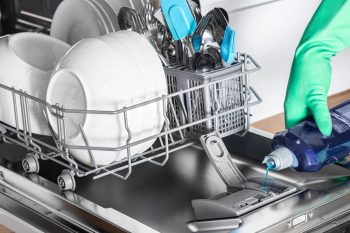
Maintaining a clean washing machine is crucial not only for ensuring your clothes come out clean, but also for the longevity and efficiency of your machine. This comprehensive guide will provide you with a step-by-step process on how to clean a regular washing machine, how often you should clean it, and what you should avoid to prevent damage.
To clean a regular washing machine, start by running a hot cycle with 2 cups of white vinegar to break down dirt and grime. After the cycle ends, add 1 cup of baking soda to the drum and run another cycle to further clean and deodorize the machine. Once the cycle is complete, wipe out the drum with a microfiber cloth. Also, remember to clean the detergent dispenser or fabric softener compartment by removing it, washing it under running water, and scrubbing off any residue before replacing it. It is recommended to clean a washing machine about once a month or every 30 cycles.
Signs Your Washing Machine Needs Cleaning
A clean washing machine is essential for fresh, spotless laundry. But how do you know when your washing machine needs cleaning? Here are some telltale signs:
- Clothes aren’t in the best condition: If your clothes come out of the wash with black stains or not fully cleaned, it could be a sign that your washing machine needs cleaning.
- Unpleasant odors: A musty or mildew smell coming from your washing machine indicates the presence of mold and bacteria, which need to be cleaned.
- Black, slimy residue: This can be found in and around the door seal and inside the drum. It is a buildup of washing detergents and fabric softeners that haven’t been rinsed away properly.
- Black spots on clothing: These can be caused by soap scum left in the machine or limescale buildup in hard water areas.
- Excessive lint on clothes: A decline in washing performance and excessive lint on clothes can indicate that your washing machine needs cleaning.
- Strange noises during the wash cycle: If your machine makes unusual noises during the wash cycle, it could be a sign that it needs maintenance.
Materials and Supplies Needed for Cleaning
To clean a regular washing machine, you will need the following materials and supplies:
- Distilled white vinegar
- Baking soda
- Microfiber cloth
- Old toothbrush
- Towel or dish towel
Step-by-Step Process for Cleaning the Interior Drum
Cleaning the interior drum of your washing machine is an integral part of the cleaning process. Here’s how to do it:
- Set the machine to the highest and hottest setting. This will help to kill germs, remove odors, and stop soap scum and limescale from building up in hard-to-see places.
- Add 2 cups of white vinegar into the detergent dispenser. If your washing machine doesn’t have a detergent dispenser, pour the vinegar directly into the drum.
- Run the cycle, allowing the vinegar to break down dirt and grime inside the drum.
- After the cycle ends, add 1 cup of baking soda to the drum. Baking soda helps to further clean and deodorize the washing machine.
- Run another cycle to rinse out the baking soda and any remaining dirt.
- Once the second cycle is complete, use a microfiber cloth to wipe out the drum, removing any remaining residue.
Frequency of Cleaning a Washing Machine
It is recommended to clean a regular washing machine about once a month or every 30 cycles. However, the cleaning frequency may vary depending on factors such as how often the machine is used, what you wash in it, and the age of the machine.
Cleaning the Detergent Dispenser or Fabric Softener Compartment
Cleaning the detergent dispenser or fabric softener compartment is also a crucial part of maintaining a clean washing machine. Here’s how to do it:
- Remove the detergent drawer: Press the release lever or button and gently pull the drawer towards you. Consult your washing machine manual if you’re unsure how to remove the drawer.
- Clean the drawer: Wash all parts under running water. You can use a toothbrush or a stiff nylon brush to scrub off any residue. For stubborn soap scum or grime, you can soak the drawer in warm water mixed with vinegar or baking soda.
- Clean the detergent cavity: Spray the cavity with distilled white vinegar and let it soak for 15-30 minutes. Alternatively, you can use a solution of hot water and liquid detergent. Scrub the cavity with a toothbrush or a small soft brush.
- Rinse and reassemble: Rinse the detergent drawer and its components thoroughly under running water. Replace the softener compartment and the liquid detergent guide, then slide the drawer back into the washing machine.
Precautions to Avoid Damage
When cleaning a washing machine, it is essential to take precautions to avoid causing damage to the appliance. Some of these precautions include using the correct type of detergent, avoiding overloading the machine, cleaning the lint filter regularly, and running an empty cycle with hot water and a washing machine cleaner or a solution of hot water, vinegar, and baking soda to rinse away soap residue and buildup.
In conclusion, maintaining a clean washing machine is crucial for its efficiency and longevity. By following the steps outlined in this guide, you can ensure your washing machine stays in optimal condition, so your clothes come out clean every time.
Frequently Asked Questions
Can I use bleach instead of vinegar to clean my washing machine?
Yes, you can use bleach instead of vinegar to clean your washing machine. However, it’s important to use it sparingly and to run an extra rinse cycle afterwards to ensure all the bleach is removed from the machine.
What should I do if the unpleasant odor persists even after cleaning the washing machine?
If the unpleasant odor persists even after cleaning, it could be due to a buildup of bacteria or mold in hidden parts of the machine such as the filter, hoses, or pumps. It’s recommended to call a professional to inspect and clean these parts.
How can I prevent soap scum and limescale buildup in my washing machine?
To prevent soap scum and limescale buildup, consider using less detergent and fabric softener, especially if you have soft water. Regularly running a cleaning cycle with vinegar or a washing machine cleaner can also help prevent buildup.
Can I use apple cider vinegar instead of white vinegar for cleaning my washing machine?
While apple cider vinegar has cleaning properties, it is not as effective as white vinegar for cleaning washing machines. White vinegar is more acidic and therefore better at breaking down soap scum and mineral deposits.
What should I do if my washing machine is making strange noises?
If your washing machine is making unusual noises, it could indicate a mechanical issue. While cleaning the machine may help, it’s best to consult with a professional if the noises persist after cleaning.












